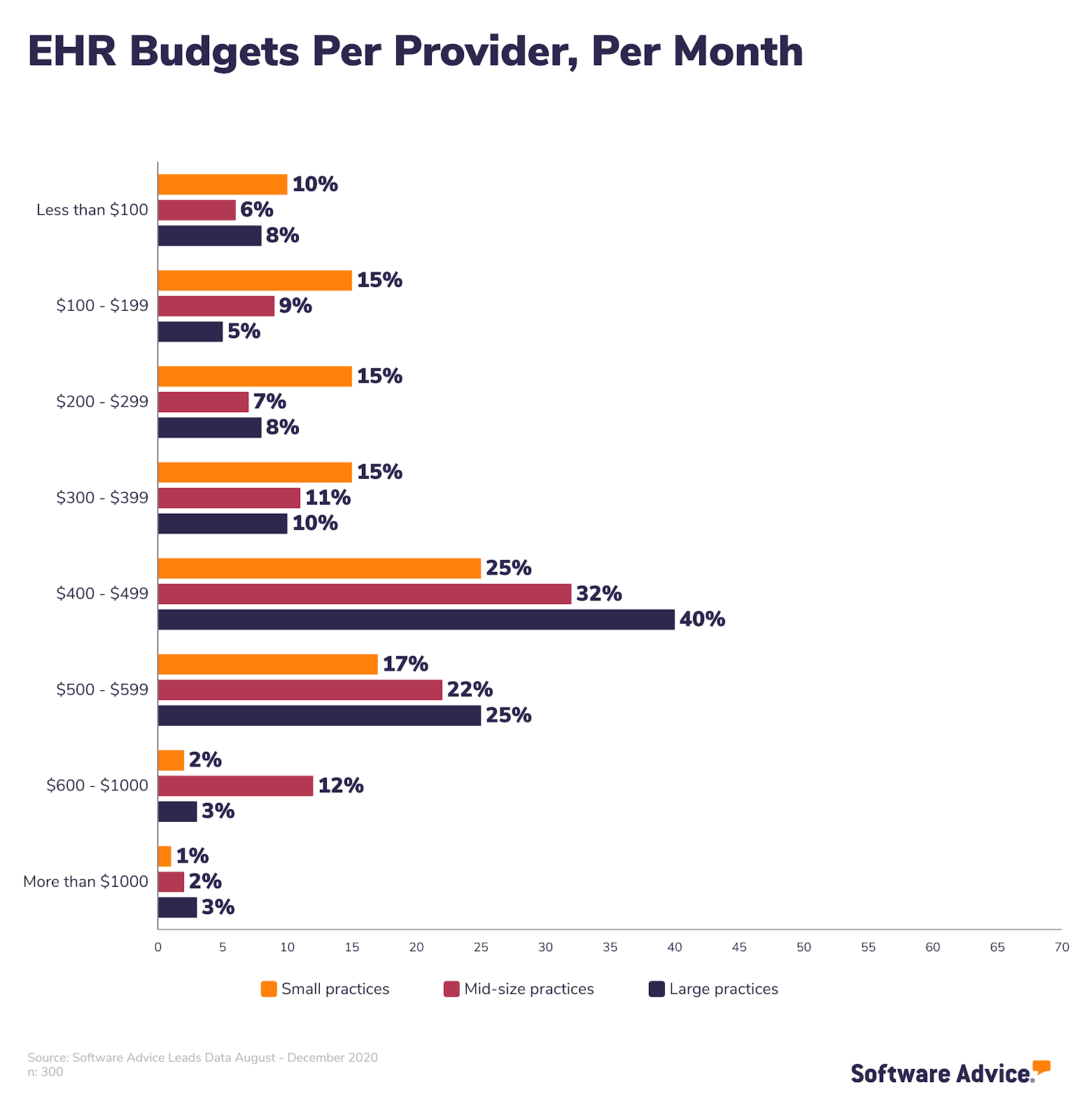EMR Pricing Explained: Your Guide to Upfront, Recurring & Hidden Costs
How much should you pay for an electronic medical records (EMR) system?
There’s no easy answer. Sometimes, even free or open source EMRs involve hidden fees that can send your original budget into a tailspin.
It can take days of online research and meetings with vendors to understand how much a new or replacement system will actually cost your business. And after all that, you might end up paying more than expected for features you need, but assumed were being offered by the vendor for no extra charge.
With this in mind, we’ve compiled this comprehensive guide to help you compare the pricing of top-rated EMR solutions, learn how much others are spending, and find the ideal product that fits your price point.
EMR pricing factors explained: Considerations and product comparisons
Medical software providers often do not disclose pricing information on their websites. Instead, they encourage potential buyers to contact their sales team for an estimate.
Part of the reason it’s so difficult to find EMR price listings is because of the many factors that can impact the total cost of ownership (TCO). Here are some factors that affect pricing:
Do you just want an EMR, or are you also interested in integrating practice management applications, such as scheduling and billing?
What types of users will access the system (e.g., doctors, nurse practitioners, physician assistants, therapists, office managers), and how many users need unique logins?
How many patients do you see each day?
Will you need extra help with training and setup, or does your office have dedicated IT staff to assist with this?
Do you need to migrate patient data from your current system, or are you a new EMR software buyer?
Based on how you answer the above questions, a vendor could quote you hundreds of dollars less or thousands more for the same system.
Even with these considerations in mind, it’s simply not efficient to call each individual software vendor just to find out whether you can afford their platform.
Luckily for you, there’s an easier way to get pricing information for many popular EMRs. Just download our report featuring detailed price ranges for top EMR systems.
Get your free software pricing guide
Pricing models demystified: Upfront, recurring, and hidden costs
When you evaluate EMR price quotes, you’ll notice two main categories of EMR pricing models: perpetual license and subscription license. You may already have a basic understanding of these options, but let’s consider the full upfront, recurring, and hidden costs of each:

Perpetual License
What it is: You pay an upfront fee for the license to own the EMR software and use it forever.
Commonly used for: On-premise deployments where the system is hosted and maintained in-house, on your practice’s own servers.
Upfront costs:
A one-time license fee (this can range from $1,200 to $500,000 and up)
Hardware (e.g., servers)
Recurring costs:
Monthly, annual, or ad hoc maintenance (e.g., updates, patches and upgrades)
Premium support offerings (e.g., expanded phone support hours)
Hidden costs:
Customization (e.g., note templates with custom fields, reporting and analytics capabilities)
Integration with existing systems (e.g., health care customer relationship management or business intelligence tools)
IT staff overtime (or hiring more IT staff) to maintain servers

Subscription License
What it is: You pay a monthly fee to use the EMR software for a specific amount of time.
Commonly used for: Cloud-based deployments, where the system is hosted remotely and can be accessed on compatible devices over the internet.
Upfront costs: Installation/setup
Recurring costs:
A monthly subscription fee per provider/user (this can range from $200 for a bare-bones system to $35,000 or more for systems used by major healthcare organizations.)
Premium support offerings (e.g., expanded phone support hours)
Hidden costs:
Customization (e.g., note templates with custom fields and reporting/analytics capabilities)
Integration with existing systems (e.g., health care customer relationship management or business intelligence tools)
Storage (e.g., extra GBs for patient data)
Once you’re familiar with the different pricing models, there are additional fees when implementing a new EMR that are equally important to understand. These extra expenses are universal, regardless of your chosen vendor’s pricing model, so make sure you’re factoring the following into your budget:
Data migration. This is when your current software vendor extracts patient data and exports it as files that can then be imported into the new EMR. This is often a surprise cost for buyers, as vendors can charge between $30,000 and $50,000 for the service.
Training. Depending on how extensive staff training for the new system is, it can cost nothing at all or several thousand dollars. These days, vendors provide a wealth of free online training materials, such as webinars and how-to videos, that can help cut down on costs. However, you might find it worthwhile to bring in an implementation specialist to get your staff up to speed as soon as possible in order to reduce costly downtime.
(Initial) productivity losses. You’ll likely lose some speed as you get used to charting and entering data into a new system. This could result in seeing fewer patients per day and a temporary dip in profits. It’s a good idea to set aside up to three months of capital to ensure your finances stay healthy during the transition.
It’s important to take these often-overlooked costs into account before you begin evaluating vendors. This way, you can add them to your budget at the start.
Doctors’ EMR budgets revealed: How much real MDs are spending
Now that you know what to expect when it comes to EMR pricing and costs, you may be curious to know how much your competitors paid for their systems. Software Advice gives you a peek into doctors’ EMR budgets to help you validate or adjust your financial planning.
Every year, our expert software advisors speak with thousands of medical practices looking for the right software. We analyzed a sample of our most recent interactions to bring you this data.
Practitioners told our advisors how much they’re willing to spend on a best-of-breed EMR systemA best-of-breed EMR system, excluding setup costs. Here are their responses, broken up by practice size.
(Note: The practices surveyed are budgeting per provider, per month for subscription-based EMRs, unless otherwise noted.)

Most practices, regardless of size, feel comfortable investing up to $500 per provider, per month on their EHR software.
Conclusion: 3 key EMR pricing takeaways
We hope all the research, tips and insights we just shared will help you avoid sticker shock when you begin evaluating EMRs. Here’s a summary of the most important takeaways:
Your needs will dictate your costs. Don’t assume that a vendor’s EMR price quote includes all the features you want or supports all the staff in your office. Be clear about your expectations and requirements so that you get to know the true cost of a product.
Seek out free resources for EMR cost comparisons. Download this Software Advice report for instant access to the pricing information of some of the top-rated EMR vendors in the market.
Beware of hidden and overlooked costs. The cost of an EMR is more than just the license fee. Be sure to factor in data migration, training and staff productivity costs when planning your budget.
When you’re ready to explore EMR providers that fit your budget and feature requirements, schedule an appointment with our medical software advisors to learn more about your options.